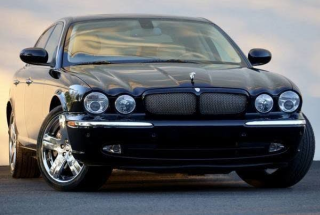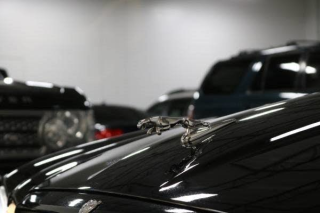The Good
The 2006 XJ-Series offers a compelling blend of potent V8 performance, exceptionally comfortable ride quality, and timeless, sophisticated design. Its aluminum construction aids in agile handling, while the luxurious interior appeals to emotional desires for prestige. Practically, the available supercharged variants provide exhilarating acceleration, and for those seeking a unique luxury experience, it presents strong value.
The Bad
Potential buyers of the 2006 Jaguar XJ-Series should be aware of common issues such as air suspension leaks, electronic glitches, and potential corrosion, especially in the subframes. Some owners report minor interior trim issues and costly repairs related to the infotainment system. Regular and thorough pre-purchase inspections are highly recommended.
2006 Jaguar XJ-Series: Quick Overview
- Engine Options:
- 3.5L V8 (less common in North America)
- 4.2L V8
- 4.2L Supercharged V8
- Horsepower:
- 3.5L V8: Approximately 257 hp
- 4.2L V8: Approximately 294 hp
- 4.2L Supercharged V8 (XJR): Approximately 395 hp
- Fuel Economy (EPA Estimated):
- 4.2L V8: Around 17 MPG city / 25 MPG highway
- 4.2L Supercharged V8: Around 15 MPG city / 23 MPG highway
- (Note: Real-world mileage can vary significantly based on driving conditions and maintenance.)
- 0-60 MPH Times (Estimated):
- 4.2L V8: Around 6.1 seconds
- 4.2L Supercharged V8 (XJR): Around 4.9 seconds
- Towing Capacity:
- Not applicable; the Jaguar XJ-Series is a luxury sedan designed for passenger transport, not towing.
- Trim-Level Features:
- XJ8: Standard features typically include leather upholstery, power-adjustable front seats, wood trim, automatic climate control, a premium audio system, alloy wheels, and various safety features. Options might include a navigation system and a sunroof.
- XJR: Builds upon the XJ8 with the more powerful supercharged engine, sport-tuned suspension, larger wheels, performance tires, unique exterior styling cues (e.g., grille, badging), and often sportier interior accents.
- Long Wheelbase (LWB) Variants: Available on both XJ8 and XJR, offering significantly more rear legroom and enhanced comfort for rear passengers.
2006 Jaguar XJ-Series Specifications
Vehicle Information
| Year | 2006 |
| Make | Jaguar |
| Model | XJ-Series |
| Trim | - |
| Style | - |
| Type | Sedan |
| Category | Mid-Size Car |
Manufacturing Details
| Made In | United Kingdom |
| Manufacturing City | BROWNS LANE |
Dimensions
| Doors | 4-Door |
| Curb Weight | 3726 pounds |
| Gross Vehicle Weight Rating | - |
| Overall Height | 57.00 inches |
| Overall Length | 200.40 inches |
| Overall Width | 76.50 inches |
| Wheelbase Length | 119.40 inches |
| Standard Seating | 5 |
Engine & Performance
| Engine | 4.2-L V-8 DOHC 32V |
| Engine Size | 4.2L |
| Engine Cylinders | 8 |
| Transmission | 6-Speed Automatic |
| Transmission Type | Automatic |
| Transmission Speeds | 6-Speed |
| Drivetrain | Rear-Wheel Drive |
Additional Features
| Anti-Brake System | 4-Wheel ABS |
| Steering Type | Rack & Pinion |
Pricing
| Manufacturer Suggested Retail Price (MSRP) | $61,830 |
| Invoice Price | $56,265 |
| Delivery Charges | $665 |
Vehicle History Report
Specifications
History
Events
History Check
Check
Check
Check
Check
Listings
Recalls
Check
Analysis
What Problems Does the 2006 Jaguar XJ-Series Have?
Another area of concern is electrical gremlins. Owners have reported issues with the infotainment system, power windows, door locks, and various sensors. These can range from minor annoyances to significant malfunctions. The complexity of Jaguar's electronics means diagnosing and fixing these problems can be labor-intensive and costly.
Corrosion, particularly on the aluminum subframes, is a long-term reliability concern, especially for vehicles in rust-prone climates. While the XJ's body is aluminum, the subframes can still be susceptible to rust, potentially compromising structural integrity.
The 4.2L V8 engine is generally robust, but like any engine, it requires diligent maintenance. Issues such as timing chain tensioner wear (though less prevalent in later iterations of this engine generation compared to earlier Jaguars) can arise over time. Also, the automatic transmission can experience issues if not properly maintained, including fluid leaks or shift problems.
Regarding recalls for the 2006 model year, it is advisable to check official NHTSA records or consult a Jaguar dealer with the specific VIN. However, common recall areas for this generation often involve airbag systems, or potential issues with the fuel system or braking components.
Long-term reliability is often a mixed bag with older luxury vehicles like the XJ. While the core mechanicals can be durable with consistent maintenance, the prevalence of sophisticated electronics and complex systems means that repairs can be frequent and expensive once the car is out of warranty. Owners who prioritize classic styling and a comfortable ride, and are prepared for potentially higher maintenance costs, may find the XJ a rewarding ownership experience. However, for those seeking absolute low-cost, trouble-free motoring, other brands might be a more suitable choice.
How long will the 2006 Jaguar XJ-Series last?
The all-aluminum construction of the XJ contributes to its structural longevity, resisting traditional rust more effectively than steel-bodied cars. However, the long-term durability is significantly impacted by the aforementioned weaknesses. The air suspension system, while comfortable, is a common point of failure past 100,000 miles and can become a costly recurring repair. Similarly, the complex electronics can become more prone to failure as the vehicle ages.
Therefore, while the chassis and powertrain can be durable, the overall lifespan and reliability are often dictated by the robustness of its intricate systems. Vehicles that have been regularly serviced by specialists familiar with Jaguar vehicles are more likely to endure longer and with fewer major issues over time.
What Technology & Safety Features are Included?
Driver-assistance features were somewhat limited by modern standards but included standard cruise control. Traction control and stability control (often referred to as DSC - Dynamic Stability Control) were typically standard, enhancing safety during adverse driving conditions. Parking sensors were available as an option on some trims.
Safety was a key consideration. The XJ-Series came equipped with a comprehensive array of airbags, including front, side-impact, and often side-curtain airbags for both front and rear passengers. The robust aluminum monocoque chassis provided excellent structural integrity in a collision. The vehicle was also equipped with anti-lock brakes (ABS) and electronic brake-force distribution (EBD).
Regarding crash-test ratings, the XJ-Series generally performed well in its time. While official crash-test data from agencies like the IIHS or NHTSA for this specific 2006 model year might be limited or vary by testing methodology, the Jaguar XJ was designed to meet stringent safety standards of the luxury segment. Its strong aluminum structure and comprehensive airbag deployment were key to its protective capabilities. Optional features could extend to features like adaptive cruise control on very late models or specific packages, though these were less common.
What Colors Options are Available?
2006 Jaguar XJ-Series Prices and Market Value
Currently, the used market prices for a 2006 Jaguar XJ-Series vary widely based on mileage, condition, trim level, and maintenance history. You can typically find these vehicles ranging from $5,000 to $15,000. The XJR models, due to their performance appeal, tend to hold their value slightly better than the standard XJ8.
Factors affecting resale value include the availability of detailed service records (especially for air suspension and electronics), the overall cosmetic condition of the interior and exterior, and whether the vehicle has been kept in a climate that prevents corrosion. A well-maintained XJ from a lower-mileage example will command a higher price. However, the inherent cost of potential repairs for aging luxury cars often weighs on their resale value.
2006 Jaguar XJ-Series Cost of Ownership
Maintenance costs can be substantial. While routine services might be comparable to other luxury brands, specialized repairs, especially for the air suspension, electronics, and aluminum bodywork, can be very expensive. Parts availability can also sometimes be an issue, leading to longer repair times and higher labor costs. Therefore, budget for higher-than-average expenses for this elegant but potentially demanding luxury car.
2006 Jaguar XJ-Series Fuel Efficiency
2006 Jaguar XJ-Series Safety Rating
NHTSA
IIHS
2006 Jaguar XJ-Series Warranty
Basic
Powertrain
Rust
2006 Jaguar XJ-Series Insurance
reasonable repair costs.
How Does the 2006 Jaguar XJ-Series Compare to Other Sedan?
Features-wise, the XJ offered a luxurious interior with high-quality materials and classic styling. While it may have lagged slightly behind the cutting-edge technology found in the latest S-Class or 7 Series at the time, it still provided ample comfort and convenience amenities. The standard air suspension contributed to a supremely comfortable ride, which was a hallmark of Jaguar's luxury focus.
Reliability is where the XJ often faced its greatest challenges compared to its German counterparts. While the Mercedes S-Class and BMW 7 Series were known for their robust engineering (though also complex and expensive to repair), the XJ had a reputation for more frequent and sometimes more esoteric electrical and suspension issues. This is a significant factor for buyers considering long-term ownership.
In terms of price, the Jaguar XJ often presented a compelling value proposition on the used market compared to its German rivals, depreciating more rapidly. This made it an attractive option for those seeking a prestigious luxury sedan at a more accessible price point.
Alternatives:
- Similar: The Lexus LS 430 (for this model year) offers a comparable level of luxury and comfort with significantly superior reliability and lower running costs. It may lack the same outright performance punch of the XJR but provides a more secure ownership experience.
- Better if Reliability is Paramount: Consider the Mercedes-Benz S-Class (W220 generation) or BMW 7 Series (E65/E66 generation) if you prioritize cutting-edge technology and a vast dealer network, but be prepared for potentially higher maintenance and repair bills.
- More Engaging Drive (but potentially less comfortable): The Audi A8 offered a sportier chassis and Quattro all-wheel drive, but its interior might feel less traditionally luxurious than the Jaguar's.
Final Verdict: Is the 2006 Jaguar XJ-Series a Good Sedan?
Whether it's worth buying depends heavily on the circumstances. As a used vehicle, it can represent excellent value for its luxury and performance quotient, but only if purchased with the understanding of potential maintenance costs. It is not recommended for budget-conscious buyers or those who prefer a hassle-free ownership experience.
Buying conditions should include a thorough pre-purchase inspection by a Jaguar specialist, with particular attention paid to the air suspension, electronics, and subframes. Specific trims like the XJ8 offer a more balanced approach to luxury and performance, while the XJR is for those who crave exhilarating speed. A meticulously maintained example with a comprehensive service history will be the most rewarding purchase, offering a taste of true luxury at a significantly reduced price from new.


